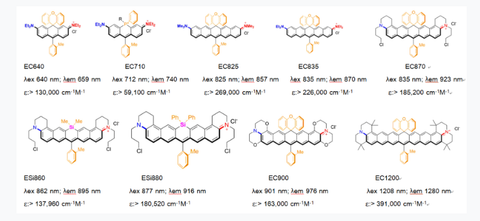EC series near-infrared fluorescent dyes are a new class of high-performance dyes developed by the research team of Professor Yang Youjun at East China University of Science and Technology (Figure 1) [1-7]. These dyes are designed to meet the growing demand for infrared imaging, photothermal ablation, and other applications in the biomedical field. When used with self-built fluorescence microscopy equipment, they allow for advanced fluorescence imaging of cells or living organisms.

figure 1 EC dyes[1]
Key Advantages of EC Series Fluorescent Dyes Compared to Traditional Cyanine Dyes
Unlike traditional cyanine near-infrared fluorescent dyes (such as Cy5 and indocyanine green), EC series dyes offer significant advantages in terms of absorption and emission wavelength, fluorescence intensity, photostability, and environmental sensitivity:
- Narrow Peaks and High Fluorescence Intensity: EC dyes feature narrow absorption and emission spectra (FWHM=45 nm) and exhibit high fluorescence intensity (ε×φ>40,000 M⁻¹cm⁻¹), making them highly effective for fluorescent labeling and imaging applications.
- Enhanced Photostability: EC dyes have a photobleaching rate that is 1/10 to 1/1000 of indocyanine green under identical conditions, ensuring longer-lasting imaging sessions.
- Biocompatibility: With an excitation wavelength (λex) below 800 nm, these dyes have excellent cell membrane permeability, making them ideal for staining cells or biological tissues.
| EC fluorescent dye | Fluorescence | Molar Extinction Coefficient |
|---|---|---|
| EC825, 97%, Near-infrared fluorescent dye, liposoluble | λex 825 nm; λem 857 nm | >269,000 cm -1M-1 |
| EC835, 97%, Near-infrared fluorescent dye, liposoluble | λex 835 nm; λem 870 nm | >226,000 cm -1M-1 |
| ESi860, 97%, Near-infrared fluorescent dye, water-soluble | λex 862 nm; λem 895 nm | >137,960 cm -1M-1 |
| EC870, 97%, Near-infrared fluorescent dye, water-soluble | λex 835 nm; λem 923 nm | >185,200 cm -1M-1 |
| ESi880, Near-infrared fluorescent dye, water-soluble | λex 877 nm; λem 916 nm | >180,520 cm -1M-1 |
Suitable for in vivo fluorescence microscopy imaging of cells and small animals
- It has excellent luminescent properties, resistance to photobleaching, antioxidant, and resistance to biothiol addition.
- Cannot cross cell membranes.
- It also has photothermal, photoacoustic and photodynamic properties.
| EC fluorescent dye | Fluorescence | Molar Extinction Coefficient |
|---|---|---|
| EC900, 97%, Near-infrared fluorescent dye, water-soluble | λex 901 nm; λem 976 nm | >163,000 cm -1M-1 |
| EC1200, 97%, Near-infrared fluorescent dye, liposoluble | λex 1208 nm; λem 1280 nm | >391,000 cm -1M-1 |
Suitable for in vivo fluorescence microscopy imaging of small animals
- It has excellent luminescent properties, resistance to photobleaching, antioxidant, and resistance to biothiol addition. Cannot cross cell membranes. It also has photothermal and photoacoustic properties.
- Among them, EC900 fluorescent dye has weak photodynamic properties, Ka<0, and is suitable for extremely acidic systems.
- EC1200 fluorescent dye has no photodynamic properties.

Professor Yang Youjun
Professor Yang Youjun, a professor and doctoral supervisor at the School of Pharmacy at East China University of Science and Technology, leads a research group focused on the design and development of fluorescent molecular probes and surgical navigation dyes, with a focus on major diseases related to biological redox. His research encompasses medicinal chemistry, pharmaceuticals, and medicinal chemistry biology. The team’s findings have been published in prominent journals such as Nature Communications, JACS (8 articles), Angewandte Chemie International Edition (3 articles), PNAS, Free Radical Biology and Medicine, Analytical Chemistry, Organic Letters, Chemical Communications, Journal of Organic Chemistry, and Sensors and Actuators B: Chemical.
J&K Scientific offers the full range of EC series near-infrared fluorescent dyes, enabling researchers to benefit from their superior performance in biomedical imaging and related applications.
